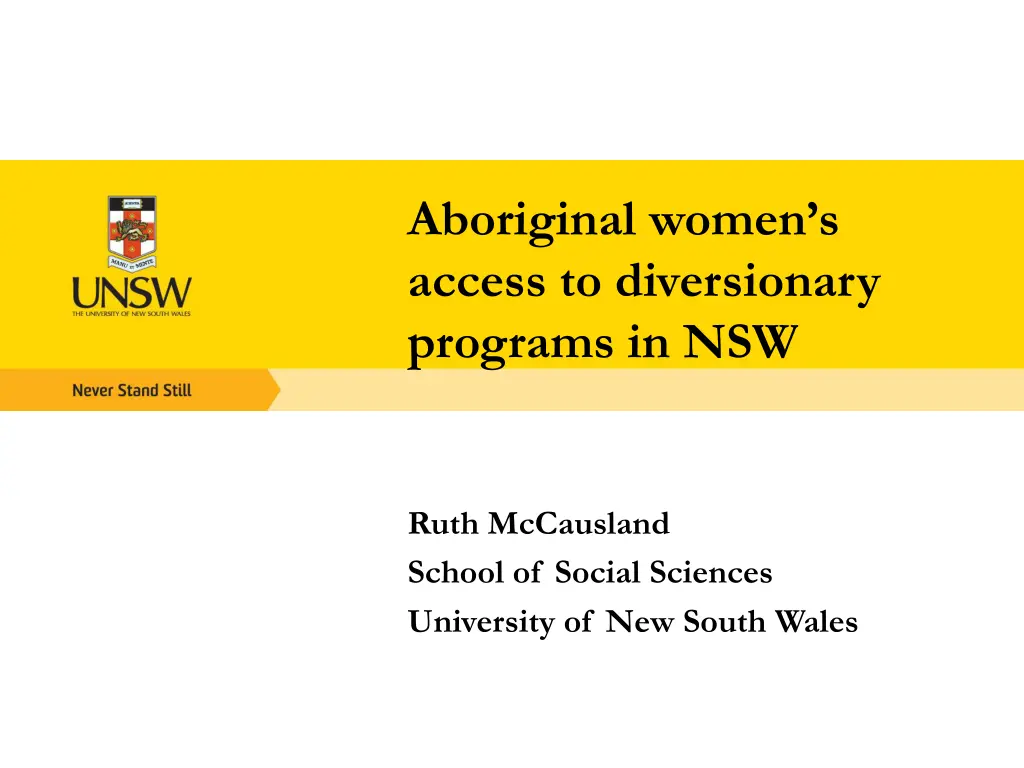
Challenges Faced by Aboriginal Women in Accessing Diversionary Programs in NSW
"Explore the barriers Aboriginal women encounter in accessing diversionary programs in NSW, affecting their overrepresentation in the prison population. Discover the findings, data, and initiatives addressing this issue. Learn about the disparities and challenges faced by Indigenous women in the criminal justice system." (Word count: 36)
Download Presentation

Please find below an Image/Link to download the presentation.
The content on the website is provided AS IS for your information and personal use only. It may not be sold, licensed, or shared on other websites without obtaining consent from the author. If you encounter any issues during the download, it is possible that the publisher has removed the file from their server.
You are allowed to download the files provided on this website for personal or commercial use, subject to the condition that they are used lawfully. All files are the property of their respective owners.
The content on the website is provided AS IS for your information and personal use only. It may not be sold, licensed, or shared on other websites without obtaining consent from the author.
E N D
Presentation Transcript
Aboriginal womens access to diversionary programs in NSW Ruth McCausland School of Social Sciences University of New South Wales
Background Aboriginal women make up 2% of the female population, but over 30% of the women s prison population in NSW Aboriginal women experience higher rates of: Mental health disorders Cognitive impairment Family and sexual violence Homelessness Return to prison
Womens Advisory Council, Corrective Services NSW Commissioned research on Aboriginal women s access to diversionary programs in NSW Participation and completion Particular barriers and challenges Literature review research and evaluations Data from diversionary program staff, BOCSAR
Diversionary programs in NSW Police cautions Pre-sentence programs MERIT CREDIT Drug Court Court intervention programs Circle Sentencing Forum Sentencing Sentencing options
Findings of research Aboriginal women were less likely than non-Aboriginal women to be referred to or complete pre-sentencing and court intervention programs MERIT 50% of Aboriginal women referred were accepted, and 58% of those completed Significant regional variance ie Circle Sentencing, CREDIT Data unavailable for Drug Court Under-represented in Forum Sentencing 15% of women Less likely to access and complete programs in custody
Sentencing data on Indigenous women NSW Criminal Court Statistics 2011: number of persons found guilty in court of selected offences by Indigenous status, gender and principal penalty Assault - 889 Theft (except mtr vehicles) - 384 Theft from retail premises - 249 Exceed the prescribed content of alcohol/other substance limit- 218 Drive while licence disqualified or suspended - 212 Possess/use illicit drugs - 178 Breach bond (supervised) 146 - 97 Breach of community service order - 82 Breach bond (unsupervised) - 82 Obtain benefit by deception - 68 Breach of suspended sentence - 47 Breach of bail - 6 Resist or hinder police officer or justice official - 131 Riot and affray - 110
Assault Total convicted Imprisoned Indigenous women 889 101 Non-Indigenous women 2288 48 Of those convicted of assault in 2011: 11.4 % of Indigenous women were imprisoned 2.1 % of non-Indigenous women were imprisoned BOCSAR NSW Criminal Court Statistics 2011: No. of persons found guilty in court of selected offences by Indigenous status, gender and principal penalty
Theft from retail premises Total convicted Imprisoned Indigenous women 249 35 Non-Indigenous women 780 25 Of those convicted of theft from retail premises in 2011: 14.1 % of Indigenous women were imprisoned 3.2 % of non-Indigenous women were imprisoned BOCSAR NSW Criminal Court Statistics 2011: No. of persons found guilty in court of selected offences by Indigenous status, gender and principal penalty
Theft (except motor vehicles) Total convicted Imprisoned Indigenous women 384 74 Non-Indigenous women 1069 42 Of those convicted of theft (except motor vehicles) in 2011: 19.2 % of Indigenous women were imprisoned 3.9 % of non-Indigenous women were imprisoned BOCSAR NSW Criminal Court Statistics 2011: No. of persons found guilty in court of selected offences by Indigenous status, gender and principal penalty
Drive while licence disqualified or suspended Total convicted Imprisoned Indigenous women 212 23 Non-Indigenous women 1229 36 Of those convicted of drive while licence disqualified or suspended in 2011: 10.8 % of Indigenous women were imprisoned 2.9 % of non-Indigenous women were imprisoned BOCSAR NSW Criminal Court Statistics 2011: No. of persons found guilty in court of selected offences by Indigenous status, gender and principal penalty
Breach of suspended sentence Total convicted Imprisoned Indigenous women 47 31 Non-Indigenous women 72 33 Of those convicted of breach of suspended sentence in 2011: 66 % of Indigenous women were imprisoned 45.8 % of non-Indigenous women were imprisoned BOCSAR NSW Criminal Court Statistics 2011: No. of persons found guilty in court of selected offences by Indigenous status, gender and principal penalty
Invisibility of Aboriginal women Aboriginal and Torres Strait Islander Social Justice Commissioner (2001): Aboriginal women remain largely invisible to policy makers and program designers with very little attention devoted to their specific situation and needs Need for an Aboriginal women-centred approach to diversionary policy and programming
Recommendations of research 1. Disaggregation of data 2. Impact Statements 3. More comprehensive evaluation 4. Expansion of sentencing options
Recommendations of research (cont.) 5. Alternative monitoring systems 6. Amendment of eligibility criteria 7. Expansion of diversionary programs 8. Staff training and resources
Recommendations of research (cont.) 9. Aboriginal Practice Checklist 10. Aboriginal staff 11. Appropriate housing 12. Holistic, one-stop shop model
